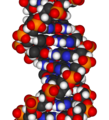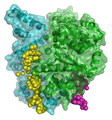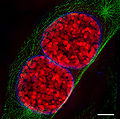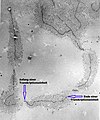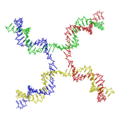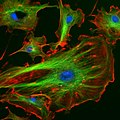Talk:Molecular models of DNA/Galleries
These are galleries removed from the article.
First batch[edit]
Examples of DNA molecular models[edit]
Animated molecular models allow one to visually explore the three-dimensional (3D) structure of DNA. The first DNA model is a space-filling, or CPK, model of the DNA double-helix whereas the third is an animated wire, or skeletal type, molecular model of DNA. The last two DNA molecular models in this series depict quadruplex DNA that may be involved in certain cancers[1][2]. The last figure on this panel is a molecular model of hydrogen bonds between water molecules in ice that are similar to those found in DNA.
Images for DNA structure determination from X-ray patterns[edit]
The following images illustrate both the principles and the main steps involved in generating structural information from X-ray diffraction studies of oriented DNA fibers with the help of molecular models of DNA that are combined with crystallographic and mathematical analysis of the X-ray patterns. From left to right the gallery of images shows:
- First row:
- 1. Constructive X-ray interference, or diffraction, following Bragg's Law of X-ray "reflection by the crystal planes";
- 2. A comparison of A-DNA (crystalline) and highly hydrated B-DNA (paracrystalline) X-ray diffraction, and respectively, X-ray scattering patterns (courtesy of Dr. Herbert R. Wilson, FRS- see refs. list);
- 3. Purified DNA precipitated in a water jug;
- 4. The major steps involved in DNA structure determination by X-ray crystallography showing the important role played by molecular models of DNA structure in this iterative, structure--determination process;
- Second row:
- 5. Photo of a modern X-ray diffractometer employed for recording X-ray patterns of DNA with major components: X-ray source, goniometer, sample holder, X-ray detector and/or plate holder;
- 6. Illustrated animation of an X-ray goniometer;
- 7. X-ray detector at the SLAC synchrotron facility;
- 8. Neutron scattering facility at ISIS in UK;
- Third and fourth rows: Molecular models of DNA structure at various scales; figure #11 is an actual electron micrograph of a DNA fiber bundle, presumably of a single bacterial chromosome loop.
Gallery: DNA molecular modeling applications[edit]
The following gallery of images illustrates various uses of DNA molecular modeling in Genomics and Biotechnology research applications from DNA repair to PCR and DNA nanostructures; each slide contains its own explanation and/or details. The first slide presents an overview of DNA applications, including DNA molecular models, with emphasis on Genomics and Biotechnology.
- First row images present a DNA biochip and DNA nanostructures designed for DNA computing and other dynamic applications of DNA nanotechnology; last image in this row is of DNA arrays that display a representation of the Sierpinski gasket on their surfaces.
- Second row: the first two images show computer molecular models of RNA polymerase, followed by that of an E. coli, bacterial DNA primase template suggesting very complex dynamics at the interfaces between the enzymes and the DNA template; the fourth image illustrates in a computed molecular model the mutagenic, chemical interaction of a potent carcinogen molecule with DNA, and the last image shows the different interactions of specific fluorescence labels with DNA in human and orangoutan chromosomes.
Gallery of AFM images[edit]
Gallery: CARS (Raman spectroscopy), fluorescence confocal microscopy, and hyperspectral imaging[edit]
Mass spectrometry—Maldi informatics[edit]
Second batch[edit]
Gallery 1: Illustration of the molecular modeling and X-ray data collection steps involved in the determination of DNA molecular structures
Gallery 2: DNA molecular modeling applications in Genomics and Biotehnology


